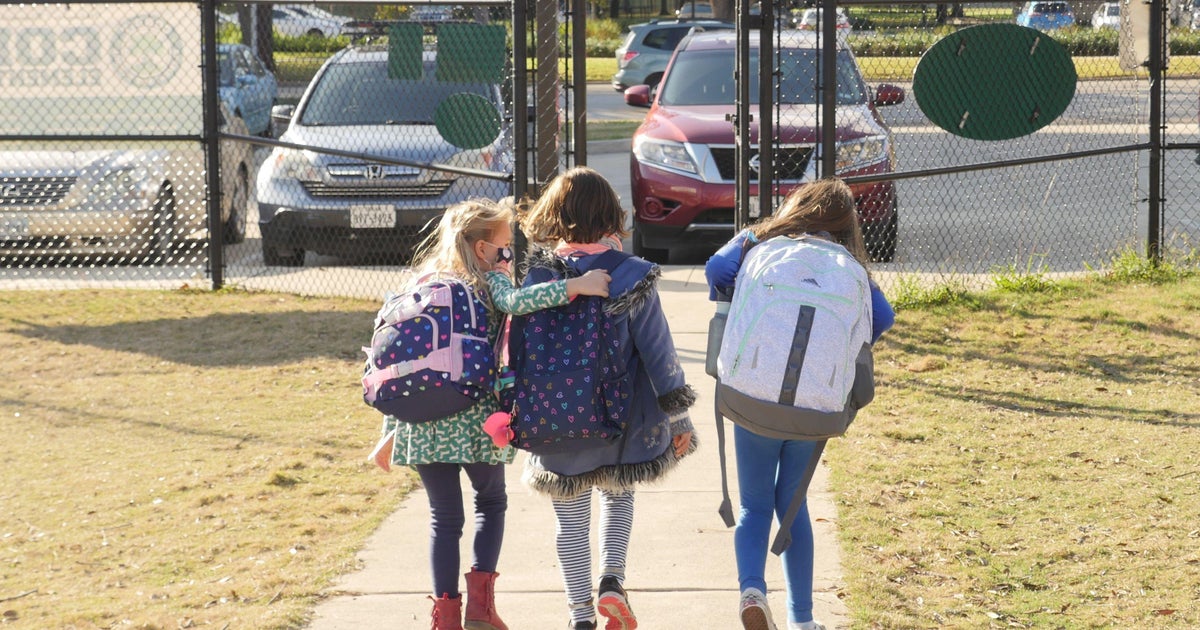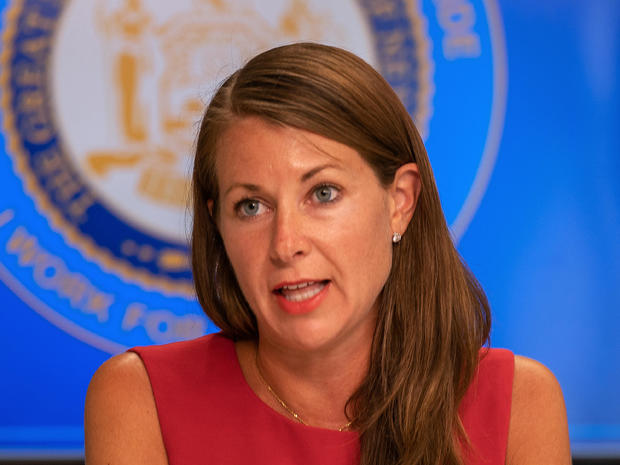
The Biden administration’s guidelines for reopening schools includes recommendations for phased reopening based on rates of community transmission, the Centers for Disease Control and Prevention said Friday.
The plan confirmed the main tenets of the guidance first reported by CBS News on Thursday.
This phased approach for reopening provides recommendations for types of instruction for K-12 schools: full in-person, hybrid, reduced attendance, and virtual-only. These are to be broken into four color-coded “zones” based on coronavirus prevalence in the area.
K-12 Schools are in the “Blue” zone if they have low community spread, and in the “Yellow” zone, with moderate transmission. Blue and Yellow Zones are recommended to allow for a reopening with full in-person learning, with as much social distancing as possible. Schools in the “Orange” zone, which are classified as having substantial transmission, are recommended to employ hybrid learning or reduced attendance, with required social distancing.
“Red” zone schools are broken into two categories: Those that engage in regular screening testing of asymptomatic staff and students and those that do not. “Red” zone schools that do not test should have hybrid learning or reduced attendance with mandatory physical distancing in elementary schools only; middle and high schools should be virtual-only. Schools that conduct screening testing can have hybrid learning or reduced attendance for all elementary, middle, and high schools, with required social distancing, according to the draft summary of the guidelines.
Based on the total of new cases per 100,000 over the past seven days, according to the CDC guidelines, here are the thresholds for community transmission and their correlating color zones:
- Blue: 0 to 9 cases;
- Yellow: 10 to 49 cases;
- Orange: 50 to 99 cases; and
- Red: More than 100 cases.
For all levels of community transmission, universal mask-wearing and testing of symptomatic individuals and their close contacts would be required.
As CBS News has previously reported, the guidelines also focus on five mitigation strategies: Universal masking; social distancing; hand-washing and respiratory etiquette; cleaning and ventilating facilities and contact tracing, isolation, and quarantine protocols.
If schools put these mitigation measures in place, access to vaccinations should not be a precondition for reopening schools, the guidance says, which is in line with recent statements by CDC director Dr. Rochelle Walensky. However, the guidance stresses that teachers should be prioritized for vaccines, and that once educators are vaccinated, schools should continue to implement these mitigation practices.
A majority of states have made some or all teachers eligible to receive the coronavirus vaccine, according to Education Week.
The guidance stipulates social distancing of 6 feet in schools. Some health officials, including a group from Harvard T.H. Chan School of Public Health, had previously argued 3 feet of social distance could be used for younger students.
The CDC also asserted that school instruction should be prioritized over extracurricular activities and sports, regardless of the degree of testing measures implemented at schools.
The guidelines also note equity concerns and recommend that funding be targeted at addressing disparities in under-resourced communities, including the implementation of costly mitigation measures such as refurbishing ventilation systems, improving digital learning gaps, and prioritizing vaccines and testing.
Accommodations for “high risk” educators, including those with high-risk family members, could include additional virtual teaching, modifying job requirements, or adopting flexible scheduling. Ongoing virtual learning should be provided as an option for students with medical conditions, the guidance states.
“With the release of this operational strategy, CDC is not mandating that schools reopen,” Walensky said Friday. “These recommendations simply provide schools a long-needed roadmap for how to do so safely under different levels of disease in the community.
Asked why she was not taking a stronger stance, Walensky explained she did not “have the authority to demand or mandate that schools open.”
The main tenets of the latest guidance mirror the CDC guidance issued in 2020 under the Trump administration. But Walensky stressed that the language in the Biden administration guidance is “stronger” and it’s “more prescriptive here as to putting some guard rails on what can and should be done in order to get to a safe reopening.”
“I can assure you that this is free from political meddling,” Walensky added, a veiled swipe at the previous administration.
“We want to be led by health and medical experts,” White House Press Secretary Jen Psaki said during a simultaneous briefing as the CDC unveiled its guidance, “As of this morning, no one on our senior staff call had seen the CDC guidelines. They are theirs to determine and release.”
The Education Department published a handbook of “practical application” to supplement the CDC guidelines.
The Biden administration has used school reopening to underscore the importance of passing their $1.9 trillion “American Rescue” COVID-19 relief package, which includes hundreds of billions of dollars in direct financial assistance to schools, as well as state and local relief funds to pay for additional school safety measures.
Mr. Biden’s current goal is to see “a majority of K-8 schools safely open in 100 days.” Psaki on Tuesday explained his goal targets a simple majority of schools with teachers instructing “at least one day a week” by day 100 of the Biden administration, which is April 30.
Asked to clarify this goal on Thursday, Psaki said “we certainly hope to build on that, even at 100 days, and from there…the President’s objective, is for all schools to reopen, to stay open, to be open 5 days a week, for kids to be learning, that’s what our focus is on.”
But many schools have already reopened ahead of the CDC guidance and additional federal funding for mitigation measures. Sixty-four percent of elementary and middle school students are already seeing some in-person instruction, according to the most current data from Burbio’s School Opening Tracker, reported by CBS News on Tuesday.
High school students are not currently included in Mr. Biden’s reopening goal. Asked by CBS News on Friday about the omission of high schools from the reopening goal, Psaki said the White House was “not going set a new goal today” but promised it will be a top priority for Education Secretary-designate Miguel Cardona once he’s confirmed.
Randi Weingarten, head of the American Federation of Teachers, welcomed the guidance and implored the CDC to “remain flexible as more data comes to light” about mutant COVID-19 strains. “The guidance is instructive for this moment in time, but this disease is not static.”
National Education Association President Becky Pringle said the new guidelines are “a good first step, but now it’s time for action.” In a statement, she asserted that “too many schools do not have in place the basic protections that the CDC has said are universally required…If they are applied universally in every community and the resources are put in place equitably for all students, our school buildings will be safe for in-person learning.”
Alex Tin contributed to this story.
Here is the CDC’s mitigation strategy:

